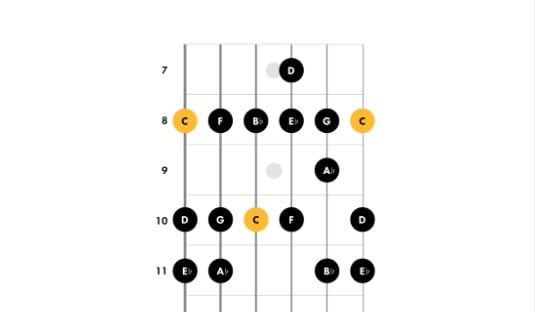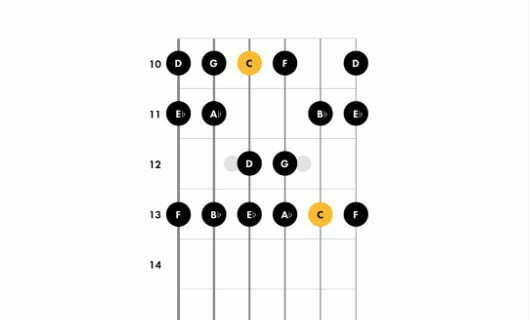How to play C minor scale on Guitar
The C minor scale is a popular choice for blues music due to its ability to balance sadness and grit. Minor scales consist of three patterns: the natural minor scale, the harmonic minor scale, and the melodic minor scale.
Like many other minor scales, C minor has been used in melancholic musical pieces to convey feelings of sadness and grief, as well as resilience and survival. Blues and jazz are two genres where you can hear the soulful sound of the C minor scale.
This lesson will focus on the C natural minor scale, covering the notes it contains and finger placement on the fretboard to play this scale in various ways.
Notes in the C minor scale
The C minor scale consists of seven notes:
- C
- D
- Eb
- F
- G
- Ab
- Bb
If you're familiar with the Eb major scale, you'll notice that it contains the same notes as the C minor scale, albeit in a different order.
In this lesson, we'll demonstrate two finger placements and positions necessary to play the C minor scale on the guitar. We'll be using the C natural minor scale for this lesson as its finger patterns are easy to remember, making it beginner-friendly
8th position
For the 8th position of the C minor scale, use your fingers as follows: index finger for the 8th fret, middle finger for the 9th fret, ring finger for the 10th fret, and pinky for the 11th fret. You'll also need to shift your hand up to play a D note on the 7th fret of the G string using your index finger, then shift your hand back down one fret and use your index finger to play the 8th fret of the A string.

10th position
To play the C minor scale in the 10th position, begin with your index finger on the 10th fret, followed by your middle finger on the 11th fret, your ring finger on the 12th fret, and your pinky on the 13th fret.

C minor scale tabs
While scale diagrams are a popular way to learn guitar scales and their structure, guitar tabs offer an alternative method. Tabs break down the learning process into more manageable steps, providing a different approach that may be easier for some learners. As both forms of notation are commonly used, it's beneficial to have a full understanding of both to avoid limitations while learning to play the guitar. Now, let's proceed to the guitar tabs for each of the C minor scales we've just learned.
8th position tablature
To play the C minor scale in the 8th position, place your index finger on the eighth fret and follow the tab, starting with the low E string.

10th position tablature
To play the C minor scale in 10th position, place your index finger on the tenth fret and follow the tab, starting with the fourth (D) string.

C minor scale exercise
Repetition is key when it comes to memorizing scales. Begin slowly and ensure that each note is played cleanly with the correct finger placement and a gentle touch. Gradually increase your speed as your finger strength improves. Practicing with a metronome can help you maintain a steady tempo.
You may also want to try playing multiple positions of the C minor scale in succession, such as starting with the 8th position and then moving to the 10th or other positions you've learned. Pay attention to the differences in pitch and tone between the same notes played in different locations on the fretboard.
In addition to learning notes and chords, scales provide an excellent opportunity to practice new techniques. Make practicing scales a regular part of your learning routine to train your fingers and ears and become a master of the guitar. Keep learning with our Guitar tunio to have best result.







